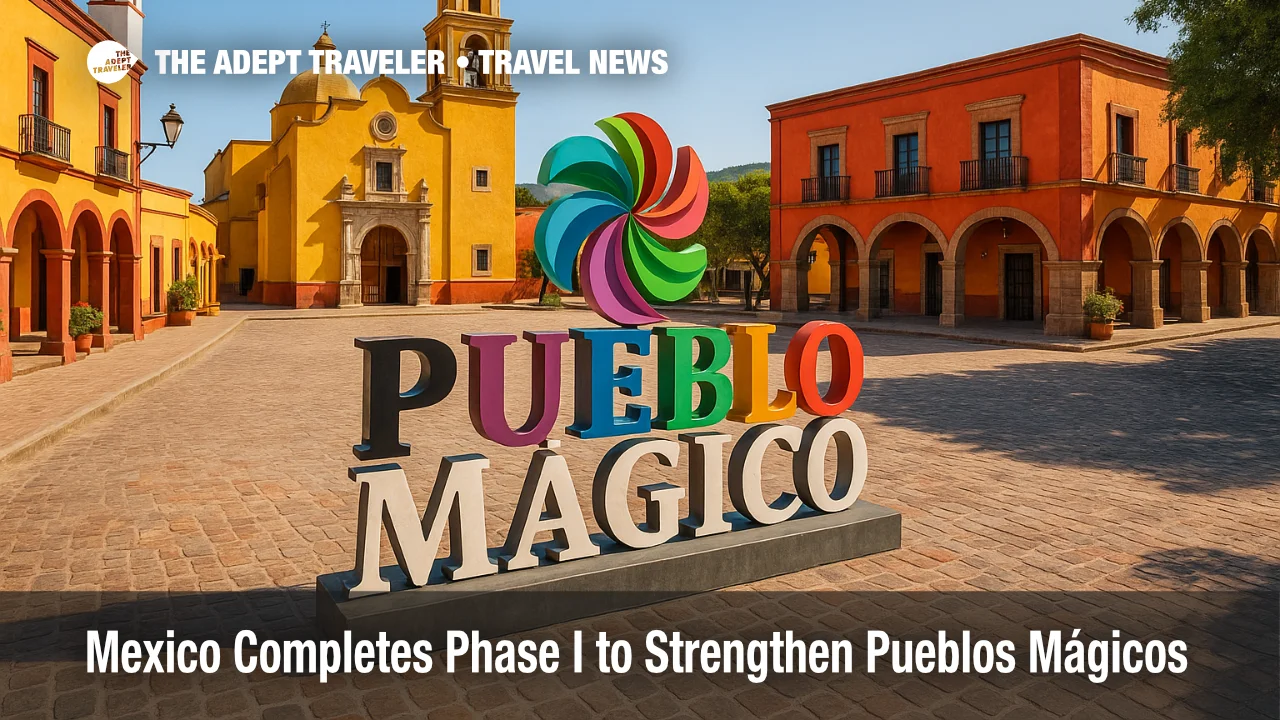Mexico completes Phase I to strengthen Pueblos Mágicos

Mexico's Ministry of Tourism has finished the first phase of a national plan to boost its 177 Pueblos Mágicos through sustainable tourism and local benefits. Officials say they have compiled 100 percent of the data needed from each town to guide next steps, including infrastructure, digital promotion, and workforce training, alongside efforts to spread demand into shoulder seasons.
Key Points
- Why it matters: Data-informed upgrades aim to protect culture while spreading tourism income to smaller communities.
- Travel impact: Expect new services, more events in off-peak months, and easier digital payments for small businesses.
- What's next: SECTUR moves into infrastructure builds, staff training, and expanded online marketing.
- Five pillars guide the plan, including sustainability, infrastructure, professionalization, promotion, and commercialization.
- Partnerships with BBVA, Visa, and México Desconocido will support finance, data, and event promotion.
Snapshot
SECTUR's "National Strategy to Strengthen Magical Towns" completed its Phase I data sweep on July 31, 2025, covering all 177 destinations. The database will steer upgrades that respect each town's identity while improving visitor services and local livelihoods. The agency is pairing public investment with private alliances to help small operators adopt card payments and digital tools, study spending patterns, and elevate cultural programming through hundreds of promoted events nationwide. Media tallies put Pueblos Mágicos visitation at more than 15 million in 2024, underscoring the stakes for residents and small businesses that rely on responsible growth.
Background
Pueblos Mágicos, such as Sayulita in Nayarit, Tulum in Quintana Roo, and Loreto in Baja California Sur, are designated for distinctive culture, cuisine, and history. The program now counts 177 towns after recent additions and sits at the center of Mexico's strategy to broaden tourism beyond marquee beach hubs. SECTUR's framework stresses sustainability and capacity building so that tourism dollars translate into local prosperity, not just visitor volume. In 2024 and 2025, federal policy has also emphasized financial inclusion and data to track the impact of tourism in these communities.
Latest Developments
Phase I done, Phase II greenlighted
SECTUR says the first stage, which assembled technical and documentary requirements for every Pueblo Mágico, ended on July 31, 2025. With Phase I complete, the ministry will begin infrastructure improvements, expand online promotion, and roll out additional training for tourism workers, while encouraging events in off-peak months to smooth demand. The goal is to professionalize, consolidate, and project these destinations as models of territorial development anchored in local identity and environmental stewardship.
Finance and data partnerships to lift small businesses
A national alliance with BBVA, branded "Avanzamos por México," will place the Mexico and Pueblos Mágicos brands across bank screens, and help micro and small tourism firms adopt terminals, payment gateways, and financial education. Visa's agreement with SECTUR adds anonymized, aggregated spend analysis to fine-tune promotion and visitor experience. Together, these moves target digital inclusion and more reliable commerce in cash-light settings popular with international travelers.
Event promotion to combat seasonality
México Desconocido, a longstanding SECTUR media partner, is supporting dissemination of 200-plus cultural and tourism events across multiple states, designed to extend stays and draw visitors beyond peak dates. The push dovetails with local training and sustainability standards so that added foot traffic protects, rather than erodes, cultural heritage.
Analysis
This is a notable pivot from counting arrivals to managing outcomes. The five-pillar blueprint, especially sustainability and professionalization, signals that federal tourism policy is moving toward measurable community benefits. The BBVA and Visa tie-ins matter because many Pueblo Mágico businesses are microenterprises that struggle with card acceptance, cash flow, and marketing analytics. If card penetration and spend insights rise, operators can adjust pricing, staffing, and inventory to meet real demand, not hunches. The event-promotion track is equally strategic, pulling demand into shoulder months and offering repeatable calendars that help small vendors plan.
Execution will be the test. Infrastructure must prioritize water, waste, and mobility solutions that match each town's carrying capacity. Training needs to reach front-line workers, not just city halls. Finally, transparent reporting, ideally via DataTur modules, should track jobs, wages, and environmental indicators so communities can hold the program accountable. If those pieces land, the Pueblos Mágicos can scale sustainable tourism while safeguarding what makes them magical in the first place.
Final Thoughts
For travelers, the next two years should bring better services, smarter payment options, and richer cultural calendars across Mexico's smaller destinations. For residents, the promise is steadier jobs and stronger local identity. The balance to watch is between growth and authenticity. Done well, the National Strategy can turn data into action and ensure that the benefits of visiting Mexico's Pueblos Mágicos reach the people who call these places home, while keeping the magic intact. Pueblos Mágicos.
Sources
- Sectur: concluye primera fase de Estrategia Nacional de Fortalecimiento de los 177 Pueblos Mágicos, Secretaría de Turismo
- Estrategia Nacional de Fortalecimiento, avances y acciones en los 177 Pueblos Mágicos, Reporte Lobby
- Sectur y BBVA fortalecen el turismo con "Avanzamos por México", Secretaría de Turismo
- BBVA México y SECTUR fortalecen el turismo nacional con una estrategia enfocada en los Pueblos Mágicos, BBVA
- La Secretaría de Turismo y Visa anuncian convenio de colaboración, Secretaría de Turismo
- México impulsa sus Pueblos Mágicos con plan de turismo sostenible, Caribbean News Digital
- México impulsa sus Pueblos Mágicos con turismo sostenible, Tus Buenas Noticias
- SECTUR y México Desconocido: alianzas y eventos, Reporte Lobby
- Datatur, módulo Pueblos Mágicos, Secretaría de Turismo
